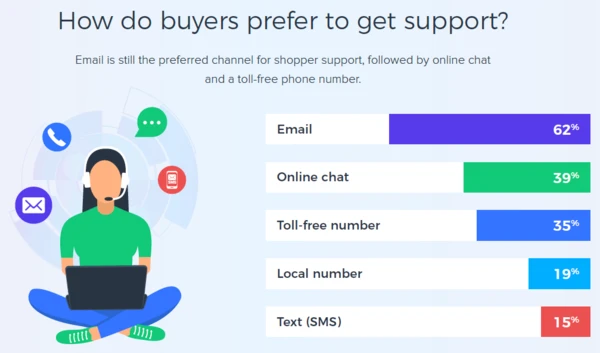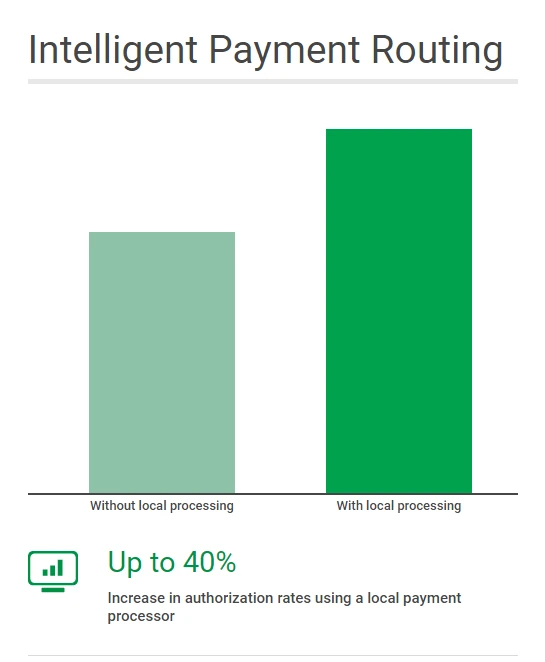How to sell abroad with the help of an international partner
Guest post by Alexandra Marcu, VP of Marketing, 2Checkout




The eCommerce turnover for Europe is estimated to reach €621 billion in 2019, and 38% of all online shoppers in Europe have ordered goods from other countries (half of those orders were placed with merchants from the EU). Furthermore, international sales make up over 40% of the total for countries located in Latin America, Africa, the Middle East, Eastern Europe, and Russia.
If your business is among the 66% of online merchants who want to tap into those expanding online commerce markets and sell abroad, your success will depend on your ability to act locally. One of the great paradoxes of eCommerce is the tension between the buyers’ hunger for global goods and their desire for a local, relevant, and trusted experience.
If you want to start selling cross-border, you will need to research your target markets in detail, adapt your pricing to each of them and—if it makes business sense—localize the entire customer experience for that market, including payment methods, currencies, checkout flows, the content of your online store (language, design), shopper support and more. You will also have to make sure you comply with all the locally applicable laws and regulations, as well as manage your sales taxes and back-office operations for those markets. All these requirements make global expansion appear like an insurmountable task, but you do not have to do it alone. Partnering with a suitable international commerce provider can make the difference between the failure or success of your international sales efforts. Keep reading to find out the most important elements you need to consider when planning to sell cross-border, and how an international commerce partner can help with each.

Understand your target markets
When it comes to global digital commerce, you can forget about the one-size-fits-all approach that treats each market the same. Connecting with global buyers requires a tailored approach that addresses each market as a separate and distinct entity. To give buyers the familiar experience they’re looking for, you’ll need to localize at least some aspects of the buying experience.
For example, if you want to sell across Europe, you will have to plan for the particularities of 50 different national markets, where your potential customers speak 24 different languages. Your efforts could pay off, however, as more than 85% of Europe’s population of almost 743 million is connected to the Internet and the European Union is stimulating cross-border commerce through such measures as forbidding geo-blocking for online shoppers.
At the same time, keep in mind that demand for particular products or services is not the same across the world. For example, while China is the world’s largest eCommerce market overall, the U.S. is the top market for software; if selling software then the United States should be on your priority list.
In Europe, the UK, Germany, and France make up almost 70% of all eCommerce turnover and also lead in software, SaaS, and online services sales (followed by Italy, the Netherlands, Spain, Switzerland, Belgium, and Denmark, respectively).
On the other hand, shoppers in Macedonia and Portugal did the most cross-border online purchases (85%), followed by Luxembourg (79%), Switzerland (64%) and Iceland (63%).
You can research your target markets yourself, but that may be time-consuming and you may also miss some crucial details relevant for your vertical, if you don’t know where to look. Alternatively, you could seek out a commerce provider that already has experience operating in that market and knows all its ins-and-outs to guide your strategy for establishing a foothold there.
Adapt pricing
Many cultural factors may influence a shoppers’ decision to buy, but one aspect that works the same across borders is pricing. Establishing an intelligent pricing strategy and adjusting it over time based on data will pay off, leading to the acquisition of more customers and, even more importantly, the ideal customers for your business.
While some components of the price—such as costs for shipping and handling—may be beyond your control, providing transparency and regional-appropriate pricing are aspects you can and should prioritize. A simple way to provide transparency is by giving the shopper the option to view the price in their local currency, including all the applicable taxes and fees. You can streamline that by employing GeoIP detection technology to identify the shopper’s location and display the local currency automatically.
Also, keep in mind that just because your product is priced competitively in one market doesn’t mean the same is necessarily true for another. Being able to easily set the pricing by location allows you to adjust your strategy to the economic reality of each market. The pricing experts at ProfitWell have determined that businesses who localize their prices can grow up to 30% faster in the localized regions, compared to companies that don’t localize pricing. By partnering with a commerce provider that offers the platform flexibility and pricing features you need, you will be able to easily adjust your prices and the way they are displayed to the different international markets you expand into.
Implement the right payment methods
Payment localization is a key determining factor in the decision to buy and is the best way to establish a level of trust and comfort that no amount of marketing or promotion can bring. Offering local payment methods and currencies in your shopping cart can improve authorization rates by up to 25%, while using local payment processors in specific markets can increase them by up to 40%.
Creating the necessary structure to localize payments on your own, however, is neither cheap nor easy. The typical payment processor, for example, will only be able to provide coverage for a single country or region. That means you’ll need to source and sign a processor for every region or country where you intend to sell, as well as set aside time and resources to integrate and maintain them. If your plans include expansion into multiple markets, finding an international eCommerce platform that can help you scale is usually the better option than trying to set up everything from scratch yourself.
In addition, supporting the preferred payment method in each market can prove critical to reducing purchase funnel friction and increasing the conversion rate. Looking at global payment trends, credit or debit cards still account for about 70% of worldwide online payments. However, certain countries favor local payment methods, so ignoring those may mean you leave money on the table. For example, iDeal is the preferred payment method in the Netherlands, used in 44% of transactions. Brazilians are partial to local credit cards with installments and Boleto Bancario, while in China Alipay makes up almost half (43%) of all online payments. An international commerce partner that supports the relevant payment methods out of the box will help you start selling in those countries straight away, with minimal effort on your part.

Another aspect to think about is payments security mechanisms such as 3-D Secure, which is used in Europe or Japan but not as much in the U.S., for example. What’s more, from September 14, 2019, all online transactions where both parties are in the European Economic Area (EEA) will need to be compliant with the Strong Customer Authentication (SCA) requirements of the European Union’s revised Payment Services Directive (PSD2). That means all payments will need to be secured with 2-factor authentication (2FA). If you are selling in the EU, you should make sure your payment service provider will be fully compliant with these requirements and can offer a good customer experience to your shoppers under the new regulations.
Avoid lost revenue with smart payment tools
The smart payment tools that a suitable international commerce partner can provide could help your business increase payment authorization rates as well as recover revenue that may otherwise be lost to churn. For instance, if you sell cross-border, Intelligent Payment Routing (IPR) can help direct transactions to the most appropriate local payment processors, potentially bringing you an up-to- 40% increase in authorization rates.

Source: 2Checkout
Smart Account Updaters can save over 90% of unusable credit cards, increasing customer retention by 40%.
Other tools you might look for in a digital commerce provider’s offering include:
- Multi-currency management
- Dynamic 3-D Secure
- Internal account updater
- Advanced retry logic
- Hard declines dunning management.
Make sure you choose a smart system that allows for feature flexibility depending on the markets you sell into, and you will see an improvement to your bottom line.
Localize the entire user experience
In addition to languages, payment methods, and currencies, buyer preferences can be very different in different markets. Buyers expect your shopping cart to reflect the local preferences and norms. To provide this familiar experience they’re looking for, you’ll need to localize every aspect of your cart, which includes everything from the text, labels, messages, and hints to date and time, phone number, prices, currencies, graphics, formatting, punctuation, and addresses.
In additions, you should test which shopping cart layout and flow works best for each region, and then fine-tune using A/B testing and other conversion rate optimization (CRO) tools. For example, our tests have shown that shoppers in Europe are more tolerant of longer, more detailed checkout forms, whereas buyers in the U.S. or Canada converted much better with very short, streamlined checkout flows. You can easily tailor your shopping cart layouts and checkout flows to different audiences if you partner with an eCommerce platform that offers the necessary capabilities and even CRO services, if needed.
Don’t forget about taxes
Regardless of where your company is based, you’re legally required to properly manage and collect the sales tax or Value Added Tax (VAT) levied on each transaction. The tax amount, the authority responsible for collecting it, and the rules governing it can differ from country to country. Furthermore, when localizing for taxes, you need to know not only how much to charge but also which entities and businesses are exempt.
Many of these operations can be automated with templates that support international commerce and have GeoIP location detection to identify the shopper’s country. Other details, such as how and where to distribute the tax proceeds, must, however, be handled by the seller (as the Merchant of Record) or its proxy partner. If you want to avoid becoming overwhelmed by tax and back-office administration processes, consider leveraging a digital commerce provider that, besides facilitating payments, can also calculate and collect the correct tax amount for each respective market and seamlessly pay them to local fiscal authorities on your behalf. You will thus receive the proceeds and be free to focus on product development and promotion.
Support
Shoppers want excellent customer service. Shopper support should involve a local phone number, localized emails (sent in local languages and during business hours), and even a toll-free number. Additionally, email follow-ups, order recovery from cart abandonment or unfinished payments, and marketing messages all need to be localized for an optimal customer experience. Depending on how many foreign markets you are targeting, it may be more practical to enlist the help of an eCommerce partner that can provide the necessary localized shopper support, as opposed to covering that yourself.

How online shoppers prefer to get support, according to the latest 2Checkout Shopper Behavior Survey.
Leverage additional channels to maximize your reach
As you grow your business globally, leveraging affiliate marketing and indirect channel sales can significantly broaden the reach of your products and expand your revenue. The channels you choose will depend on your resources; resellers may provide a higher average order volume, but they need more engagement, while affiliates may bring in smaller orders but require lower commitment on your part. Either way, managing these additional channels should not burden your business with added complexity that would negate any benefits they might provide. Partner with a commerce provider that can make channel management easy for you, through automation, partner portals, and so forth. If they facilitate access to affiliate networks for your products, even better—sales through affiliates can generate an average of 23% of the revenue for those merchants that use them.
Next steps
To succeed in expanding globally and optimizing the customers’ experience in each market, you should consider choosing a partner with the right combination of global eCommerce capabilities, relationships, and experience. Here are the main criteria you should look at as you embark on your selection process for a digital commerce provider that can help you sell cross-border:
- Does the vendor have the tools and relationships to effectively accept, manage, and optimize payments across every market?
- Can the payment partner accept local payment methods?
- An eCommerce provider may be able to localize the cart for multiple markets, but can it also deploy it as part of a broader eCommerce strategy that integrates testing, automation, optimization, and analytics for true revenue maximization?
- Can the partner help you pivot to each market’s preferred pricing model easily?
- Do they have the local expertise and relationships to capitalize on each region’s preferred marketing and promotional channels?
- Can you offload tax and back-office operations to your commerce partner, so you can focus on business development instead?
Any international commerce partner you chose should have the capabilities and flexibility to help you implement all the aspects of localization that will decisively impact your sales in global markets.

